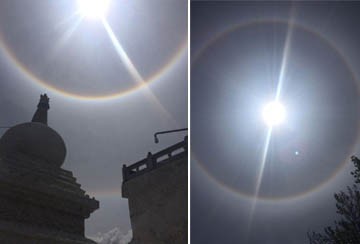LONDON, May 8 -- Scientists created a new simulation to study the evolution of the universe, which is more complete than previous simulations and could reproduce features such as galaxy distribution and composition, according to a paper published in the reputed journal Nature on Thursday.
Previous simulations have broadly reproduced the "cosmic web" of galaxies that is seen in the universe, but failed to create mixed populations of galaxies or predict gas and metal content.
The new model correctly predicts characteristics described in observational studies, and represents a considerable step forward in modeling galaxy formation, researchers said.
American scientists from the Massachusetts Institute of Technology (MIT) created the simulation, together with their British and German partners. The new simulation starts 12 million years after the Big Bang and traces 13 billion years of cosmic evolution.
The model yields a mix of spiral and elliptical galaxies with hydrogen and metal content in agreement with observational data. The team attributed the success of their new simulation to rapid advances in computing, improved numerical algorithms and better models of relevant physics.
These factors allow them to simultaneously model the evolution of different components of galaxy formation, including that of baryons and dark matter. The authors noted that the predicted effects of baryonic matter on dark matter distribution might have implications for future studies of universe evolution.
 When we are young...
When we are young... Solar halo occurs in Lhasa
Solar halo occurs in Lhasa Photos give cheongsam a new life
Photos give cheongsam a new life Graduates bid farewell to campus in clown costume
Graduates bid farewell to campus in clown costume Badain Jaran Desert: Amazing curves of nature
Badain Jaran Desert: Amazing curves of nature Beautiful Chinese-built roads in Africa
Beautiful Chinese-built roads in Africa High fashion trend welcomed by costumers in Changsha
High fashion trend welcomed by costumers in Changsha About 100 cubs expected to be born in NE China's Siberian Tiger Garden
About 100 cubs expected to be born in NE China's Siberian Tiger Garden China wins 19th women's team title at table tennis worlds
China wins 19th women's team title at table tennis worlds The 'Chinese Dad'
The 'Chinese Dad' Chinese mountaineer's gear list
Chinese mountaineer's gear list  Newly recruited police in Hetian hold drill
Newly recruited police in Hetian hold drill  China's most luminous celebrities
China's most luminous celebrities Top 10 most expensive cars in the world
Top 10 most expensive cars in the world 'African Street' in Guangzhou
'African Street' in GuangzhouDay|Week|Month